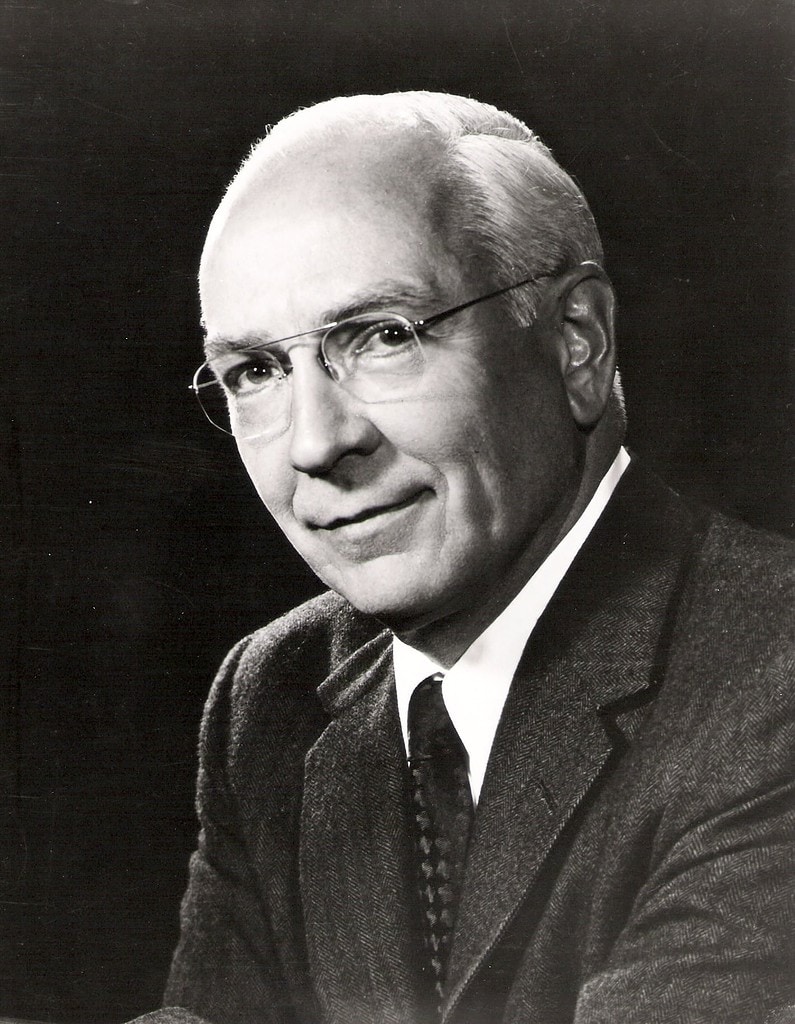Bill Quarton’s Big Idea Brought to Life

Nearly forty years ago, Bill Quarton had an idea. What if Cedar Rapids, his beloved chosen home, had an organization that looked out for the community and everyone in it? What if that organization made it easy for those with resources to help those in need?
Although Bill’s idea was new to Cedar Rapids, it wasn’t an entirely novel concept. The first community foundation was established in 1914 in Cleveland, Ohio and there was plenty for him to learn about the growing field of community-based philanthropy. Ever inquisitive—and well-connected from his many years as a broadcast executive—Bill tapped into his network to find a way to bring the idea to life.
“Bill came to me in 1985 and told me he wanted to see Cedar Rapids have a community foundation,” said Darrel Morf, an estate planning attorney with Simons Perrine Moyer Bergman PLC. “A community foundation would give an opportunity for a large number of people, many without the same kind of resources he had, to have an impact on the community.”
The Community Welfare Foundation, which had existed in Cedar Rapids since 1949, caught Bill’s eye. The organization had been established with a vision much like Bill’s, but without significant benefactors or broad public support, had not achieved a great deal of success. As it turned out, Lew Van Nostrand, a good friend of Bill’s, was on the Community Welfare Foundation’s board of directors.
“Bill had the insight to see that it needed to be converted to a public charity,” Darrel explained. As a private foundation with limited assets, the organization was both significantly constrained and unappealing to donors. But Bill’s vision created a classic chicken-and-egg problem: converting the organization to a public charity would garner public support, but public support was required to make that conversion.
And so, Bill Quarton issued a challenge to his peers.
If others in the community would contribute a total of $450,000, Bill would match that sum himself, thereby tripling the foundation’s assets at that time.
The challenge was an absolute success. During the five-year provisional period required by the IRS, the organization received enough public support to become the public charity known as the Greater Cedar Rapids Community Foundation, and things never really slowed down after that. Today, the Community Foundation has grown to hold over $200 million in assets.
“In the first several years, opportunities for donors to do various things developed with donor-advised funds and so forth,” Darrel said. The Community Foundation was also growing a pool of unrestricted funds during that time. “This was exactly what Bill had intended, and his initial gift and vision were the driving forces.”
Of course, Bill’s support—for Cedar Rapids as a whole and the Community Foundation specifically—did not end with this challenge. Bill’s success in radio and television allowed him to be a generous supporter of the Cedar Rapids Museum of Art, Community Health Free Clinic, both St. Luke’s and Mercy Hospitals, Coe College, and wide range of other organizations that helped Cedar Rapidians lead happy, healthy and creative lives.
“Bill was very generous both during his life and in his death,” Darrel said. And it was in his death that Bill made what has likely been his most impactful gift.
In 2007, at the age of 104, Bill passed away and left $35 million to the Greater Cedar Rapids Community Foundation. This gift, which remains the single largest in the organization’s history, tripled the Community Foundation’s unrestricted assets, providing valuable flexibility in responding to local challenges and opportunities.
For those that knew Bill, his desire to make an unrestricted gift was perhaps not a surprise. “I have always looked ahead, never backwards,” he wrote in his 2005 autobiography. Even then, at age 102, Bill was considering the future of his community.
“What drove Bill to make a large unrestricted gift emanates from his vision of what a community foundation could do and be,” Darrel explained. That vision was of an organization that adapted to fit its community’s needs—needs that might arise from events such as floods, windstorms, or pandemics. “Unrestricted giving permits the Community Foundation to respond to needs that could not have even been contemplated at the time the gift was given. The Community Foundation is able to be very nimble in providing responses, and that is exactly what Bill intended,” Darrel said.
Of course, there has been no shortage of challenges in Linn County since Bill’s passing. After the devastating flood in 2008, Bill’s gift in 2007 became a vital piece of the community’s recovery. “It is difficult to imagine our flood recovery efforts without Mr. Quarton’s gift,” said Karla Twedt-Ball, Senior Vice President, Programs and Community Investment. “The needs were both significant and diverse, but we had the flexibility to provide support when and where it was needed most.”
Because of Bill’s gift and those from many other donors, the unrestricted Community Endowment Fund is nearly $40 million, or 20 percent of the Community Foundation’s total assets. It continues to provide flexible resources and grants that have helped see our community through trying times like the current pandemic and derecho recovery.
“Having an unrestricted fund as large as ours is unique in comparison with community foundations in our state and across the United States,” said Les Garner, President & CEO. “Our Community Endowment Fund allows us to have grant programs that assist local nonprofits with a wider range of ways. We can support innovative ideas, sustainability, as well as organizational development needs.”
In both the good times and the bad, Bill’s vision has provided a path forward for Linn County. His legacy is one of true commitment to the community he loved dearly. “Cedar Rapids has been my home for nearly seventy-five years,” he wrote. “I am pleased that I could be a part of the city’s growth and welfare.”
To learn more about Bill Quarton and the William Quarton Heritage Society at the Community Foundation, click here.
